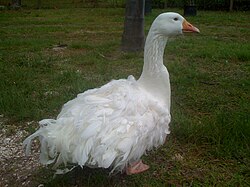Sebastopol goose

The Sebastopol is a breed of domestic goose, descended from the European Graylag.[1] They were also referred to as Danubian geese, the preferred name in 19th century Britain.[2] The Sebastopol is a medium-sized goose with long, white curly feathers. The feathers of the neck are smooth and sometimes greyish-brown. Crosses have produced all-gray, buff, and saddle back variants.[3][4] Feathers on the breast may be curly (frizzle) or smooth. The gander weighs 12-14 lbs while the goose weighs 10-12 lbs. The legs and shanks are orange and the eyes bright blue. On average, females produce 25-35 eggs per year.[5]
Though geese generally retain some flight ability, Sebastopols cannot fly well due to the curliness of their feathers and have difficulty getting off the ground.[6][7] They need plenty of water in order to keep themselves clean, and to clean their sinuses (as do all waterfowl).[8]
In German, they are called Lockengans or Struppgans, meaning "curl-goose" and "unkempt goose".
History
The breed was developed in Central Europe along the Danube and the Black Sea.[9][10] It's not known if the birds originated in the port of Sevastopol, Ukraine as the name implies, by the 19th century they were found in all the countries surrounding the Black Sea. The alternate name Danubian reflected their prevalence around the river Danube.[2] They were originally bred to use their curly feathers in pillows and quilts.[11]
Breeding
Breeding over the last hundred years has increased the average weight of the birds by thirty percent.[12] It is best to avoid breeding two specimens both having curly breast feathers, as they may develop abnormal wings.[citation needed]
See also
Gallery
-
Sebastopol Goose and Goslings
-
White Gosling
-
White and Blue Goslings
-
Rare saddleback color scheme
-
Close up of saddleback back coloring
-
Two white Sebastopol's
References
- ^ Holderread (1981) p.24
- ^ a b Ashton (1999) p.32
- ^ Ashton (1999) p.33
- ^ Holderread (1981) p.38
- ^ Holderread (1981) p.25
- ^ Holderread (1981) p.19
- ^ Luttmann (1978) p.38
- ^ Domestic Waterfowl Club Sebastopol article
- ^ Wright (1885) pp. 570-572
- ^ Tegetmeier and Weir (1867) pp.315-316
- ^ Kear and Hulme (2005) pp.6-7
- ^ Ashton (1999) pp.32-33
- Ashton, Chris (1999) Domestic Geese ISBN 1-86126-271-X
- Holderread, Dave (1981) The Book of Geese: a Complete Guide to Raising the Home Flock ISBN 0-93134-202-3
- Kear, Janet and Hulme, Mark (2005) Ducks, Geese and Swans ISBN 0-19854-645-9
- Luttmann, Gail and Rick (1978) Ducks & Geese in your Backyard ISBN 0-87857-224-4
- Robinson, John H. (1912) Principles and Practice of Poultry Culture
- Tegetmeier, William Bernhard and Weir, Harrison (1867) The Poultry Book: Comprising the Breading and Management of Profitable and Ornamental Poultry their Qualities and Characteristics
- Wright, Lewis (1885) Book of poultry
- Domestic Waterfowl Club Sebastopol article
- Feathersite web site Sebastopol article
External Links
- Sebastopol Geese Photos and Breed Information on poultrykeeper.com






